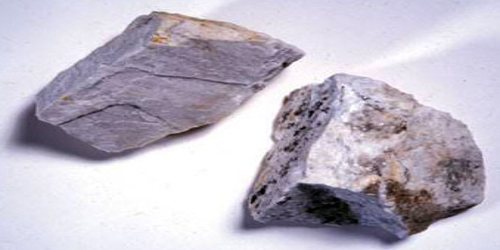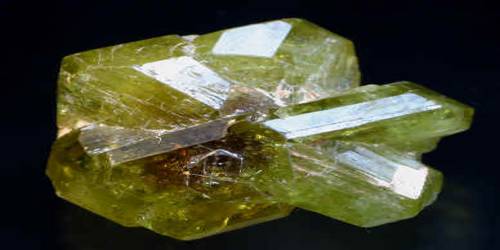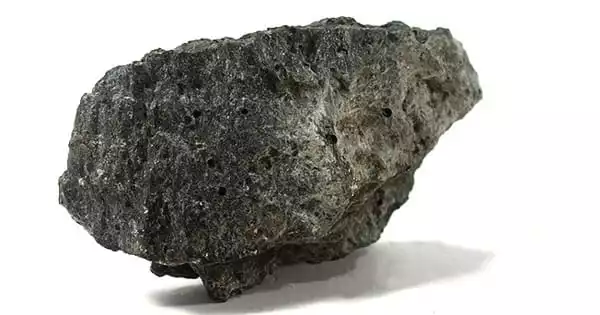Definition –
Plagioclase is a series of tectosilicate (framework silicate) minerals within the feldspar group, that form a solid solution series ranging from pure albite (Ab), Na(AlSi3O8), to pure anorthite (An), Ca(Al2Si2O8). The two intermingle and form a continuous chemical range (called a solid-solution series) between albite and anorthite (the end-members of the series). Intermediate members are homogeneous mixtures of the pure end-members.
The name “plagioclase” is frequently used instead of one of the more specific names in the table above. This is because the minerals of the plagioclase series are very similar and difficult to tell apart without laboratory testing. Thus the name “plagioclase” is commonly used in many field and classroom situations.
This was first shown by the German mineralogist Johann Friedrich Christian Hessel (1796-1872) in 1826. The series ranges from albite to anorthite endmembers (with respective compositions NaAlSi3O8 to CaAl2Si2O8), where sodium and calcium atoms can substitute for each other in the mineral’s crystal lattice structure. Plagioclase in hand samples is often identified by its polysynthetic crystal twinning or ‘record-groove’ effect.
The Plagioclase Feldspars are important rock-forming minerals and occur in numerous mineral environments. In many instances, it is very hard to tell apart one from another. When a particular Plagioclase Feldspar cannot be identified, it is simply called “Plagioclase” or “Plagioclase Feldspar”. The percentages of sodium and calcium for each member listed above are an approximate value; the actual percentage can vary as much as 20 percent.
Plagioclase is a major constituent mineral in the Earth’s crust, and is consequently an important diagnostic tool in petrology for identifying the composition, origin and evolution of igneous rocks. Plagioclase is also a major constituent of rock in the highlands of the Earth’s moon. Analysis of thermal emission spectra from the surface of Mars suggests that plagioclase is the most abundant mineral in the crust of Mars.

Occurrence and Properties of Plagioclase –
Members of the plagioclase group are the most common rock-forming minerals. They are important to dominant minerals in most igneous rocks of the Earth’s crust. They are major constituents in a wide range of intrusive and extrusive igneous rocks including granite, diorite, gabbro, rhyolite, andesite, and basalt. Plagioclase minerals are important constituents of many metamorphic rocks, such as gneiss, where they can be inherited from an igneous protolith or formed during the regional metamorphism of sedimentary rocks.
Crystals are rare for the Plagioclase Feldspars, except for Albite and Oligoclase. Crystals are usually flat and bladed, and commonly in compact groupings. Also occurs as tall prismatic and short, stubby, tabular crystals. These crystals are frequently in groupings, but may also occur singly on a matrix. Crystal twins are somewhat common. Other forms include grainy, massive, columnar, rosette, and rounded. Crystals are often striated.
The primary importance of plagioclase, however, derives from its role in rock formation. Oligoclase, the most common plagioclase, occurs in granite, diorite, and other felsic igneous rocks and in some metamorphic rocks; notable occurrences are at Aust-Agder, Norway, and Fine, New York, United States. Andesine, less common, occurs in many granular and volcanic rocks with intermediate silica content, as in Marmato, Colombia, and Bodenmais, Bavaria, Germany. The rarest plagioclase is bytownite, which occurs in basic igneous rocks and in stony meteorites.
All feldspar minerals have two directions of perfect cleavage. It is usually easy to distinguish plagioclase feldspars because their two planes of cleavage intersect at 90-degree angles, and their cleavage faces often display striations. These properties make plagioclase feldspars relatively easy to identify with a hand lens in coarse-grained igneous and metamorphic rocks. Plagioclase in granitic rocks is normally white, pink, or red in color. In basaltic rocks, it is normally gray to black.
The intermediate members of the plagioclase group are very similar to each other and normally cannot be distinguished except by their optical properties. The specific gravity in each member (albite 2.62) increases 0.02 per 10% increase in anorthite (2.75).
Uses of Plagioclase –
Plagioclase is actually used in the manufacture of glass and ceramics; the iridescent varieties peristerite and labradorite are valued as gemstones or ornamental material.
Some rare specimens of plagioclase exhibit optical phenomena that make them highly desirable gem materials. Many people enjoy the adularescence of moonstone, the aventurescence of sunstone, and the labradorescence of labradorite.
Information Sources:
















